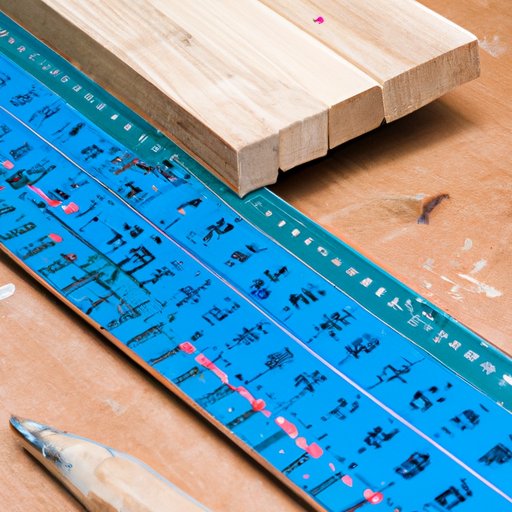I. Introduction
Board feet are a measurement used in the woodworking and construction industries to quantify the volume of lumber used in a project. Understanding how to calculate board feet is essential for anyone working with lumber. It helps to ensure that the right amount of material is purchased, reducing excess waste and saving time and money.
II. Quick and Easy Guide to Calculating Board Feet for Woodworkers
When calculating board feet, the process involves finding the volume of the lumber based on its length, width, and thickness. Multiply these measurements and divide the result by 144, which is the inches in a board foot. This easy guide will walk you through the process with step-by-step instructions.
Example:
- A piece of lumber is 6 feet long, 6 inches wide, and 1 inch thick
- Multiply 6 feet by 12 inches to get 72 inches long
- Multiply 6 inches wide by 1 inch thick to get 6 square inches
- Multiply 72 inches long by 6 square inches wide to get 432 cubic inches
- Divide 432 cubic inches by 144 to get 3 board feet
Board feet are used in woodworking projects to ensure accurate ordering and provide a rough cost estimate. For example, if you’re building a bookshelf using 15 board feet of lumber and the cost of the lumber is $4 per board foot, then the cost of the lumber would be $60.
III. Mastering the Art of Board Foot Calculations: Tips and Tricks
Knowing the basic formula for calculating board feet is only half the battle. Understanding how to apply them and use more advanced tips and tricks can save time and improve accuracy. Some tips and tricks to keep in mind:
- Buy extra lumber- it’s always better to have more than not enough
- Always measure twice- to avoid any errors
- Use dry lumber- it’s easier to calculate board feet when the lumber is dry
- Know your lumber grades- lumber is categorized by grades and may have different dimensions based on the grade
- Use apps- There are several apps available, like the BoardFeet app or Woodshop Widget, that can assist in calculating board feet accurately
IV. The Importance of Accurate Board Foot Calculations in Construction
Similar to woodworking projects, construction projects rely on accurate calculations of board feet. A common error is not accounting for small variations in dimensions or failing to account for waste. These errors can lead to a significant over or underestimation of materials needed in a project, leading to delays and cost overruns.
For example, if a construction crew orders lumber based on an estimate of 1000 board feet, but due to miscalculations, it requires 1200 board feet, it will set the project back and cause it to go over budget.
V. Calculating Board Feet Made Simple with these Free Tools
While calculating board feet manually is simple, digital tools can make the task even more straightforward. Some of the free tools available are:
- Calculator.net- Provides an online board feet calculator
- Woodshop Widget- An app that can be downloaded to your phone
- Boardfeetizer- A free app that is available for iPhone and Android devices
The advantage of using these tools is that they are faster, user-friendly, and minimize any calculation errors. However, manual calculations build the foundational understanding and skills of how to calculate board feet accurately, which is valuable in the long run.
VI. Demystifying Board Feet: A Comprehensive Guide for Beginners
What are board feet, and why are they important to woodworkers and construction workers?
Board feet calculations can be challenging for anyone starting in the woodworking or construction industry. It is essential to understand how to measure board feet to prevent overspending or underestimating the lumber required. Roughly defined, a board foot is the volume of lumber that measures 12 inches long, 12 inches wide, and 1 inch thick or its cubic equivalent. Knowing the board feet formula, and examples like those shown earlier, helps in selecting the right lumber for the project and avoids excessive waste. The proper calculation of board feet helps with measuring the right amount of lumber required for the project, reducing costs, and minimizing waste.
VII. Conclusion
In summary, calculating board feet is an essential skill for woodworkers and construction workers to master. It is necessary for calculating wood requirements, minimizing waste, and keeping projects within budgets. Remember to double-check measurements, assess lumber grades, and use tools where necessary. With this information, you can start your journey to becoming an efficient and effective woodworker or construction worker.
